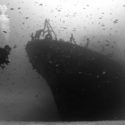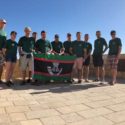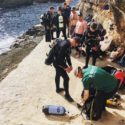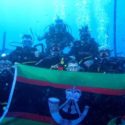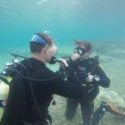On the 19th October 2017, 10 reservists and 1 regular soldier boarded a flight to Malta in order to begin Exercise Tiger Rifles Azure; the annual 6 RIFLES scuba diving expedition. The aims of the exercise were to qualify divers ranging from Ocean Diver to Dive Leader, develop the skills and experience of divers, and exercise the planning ability of JNCO’s, SNCO’ and Officers. The trip was supported by a Musician from the band of the Royal Artillery, who joined us as a guest instructor and additional supervisor.
Arriving in Malta was the first step; from there we would catch a transfer to a ferry which carried the group to Gozo where our rental 4×4 vehicles would be waiting. Travelling around the beautiful island and soaking up the landscape in our open top rented vehicles, we finally reached the self-catering apartments which would be our base for the next week. After checking the breathing air quality from the local dive shop and being issued with enough lead weight, we returned to the accommodation for a brief before our first full day of diving.
The first couple of dives were achieved at a popular dive site known as the “Double arches”, in the sheltered waters of Xwejini bay. The purpose of these dives was to readjust to the underwater environment and allow for some underwater skills work to be done before we moved to some deeper and more demanding dive sites. The maximum depth reached was 25m, but the clarity of the water allowed you to see much deeper and admire the marine life that congregated around the reef. The next day we travelled to the world famous “Blue hole”; a rock formation known as the Azure Window stood here but was destroyed in a storm earlier this year. This site was described as one of the best dives in the world by oceanographer Jacques Cousteau and it lived up to the hype. After entering the water, the seabed very quickly falls away revealing an underwater coast covered in coral and large rock formations which have chimneys and can be explored. This site was very popular when we arrived. At one point I counted a train of around 40 divers exiting from the underwater chimney. However, despite some crowding around the Blue Hole the diving was excellent. In the search for another dive site more suitable for conducting basic skills with the Ocean and Sport diver trainees we moved to a site at Ta Cenc, however the wind soon picked up and the diving became more challenging as the afternoon progressed. The site offered a chance to test the underwater navigational skills of the Dive Leaders (with varying degrees of success), whilst looking for the elusive population of Seahorses that live there.
The third day of diving added another level of complexity. The picturesque dive site of the Comino caves is a short boat ride from Hondoq bay, and boasts the wreck of the P31; a minesweeper vessel that was deliberately sank in 20m of water. The water was crystal clear and as we entered the water from the side of the boat, allowing for some great photo opportunities before breaking back into our buddy pairings and penetrating the wreck. The added complexities of diving from a boat and penetrating wrecks were handled well by our group, and Lt Heveran has since claimed “It is probably my favourite wreck dive to date”. The second dive of the day was on a site at the neighbouring island of Camino. We anchored in a sheltered cove which was used by Hollywood directors in the 2002 adaptation of ‘The Count of Monte-Cristo” as the location of the fictional Château D’If and treasure cache at MonteCristo. The site boasts caverns and caves with some impressive geology, notably the ‘Zorro’ cave. The shallow water in the caverns is often visited by tour groups, and meant that our buoyancy control had to be spot on in order to avoid the risk of being hit by the Camino PowerJet party boats. After a brief change of diving cylinders we headed back to Malsaforn bay and prepared for a night dive. Diving at night allows you to see a completely different type of marine life, but carries with it a host of new control measures to make the dive safe. In the dark, every diver looks alike, so coloured markings and additional lighting are required. Communications are also very difficult, so discipline and situational awareness are exercised more so than in a daylight dive. Visibility on this dive had closed in due to the growing wind and tide, and it was much more like diving in the UK with the notable exception of the water temperature. The resting fish and hunting octopus were a welcome distraction from the difficulties in navigation and constant fouling of the surface marker buoy line. After a challenging 40 minute dive, we emerged from the water in exactly the right place –much to my own elation as the navigator!
Day 4 of diving took us to a dive site known as Raz-il-Hobz, or “Russell Hobbs” to your average brit abroad. This site is also known as the ‘middle finger’ by the locals due to the large limestone pillar that extends 40m from the seabed to just under the surface. Diving this site was a real pleasure. The crystal clear water and shoaling marine allowed for a very enjoyable dive. We arrived on site as the wind was just starting to build. Our first wave of divers entered and exited without any issues, but by the time the second wave came out the wind had made it unsafe to stay on site for the whole day. We made the decision to move back to the sheltered water of Ta Cenc, but upon arrival we noticed that the current was a little more dramatic than we last saw; it was still a safe dive, so we continued. There were some basic skills to be practiced, so after some controlled rescue lifts we proceeded to explore the side of the site that we missed on the previous dive. Still there were no Seahorses and the current had picked up to make the visibility turn awful, so we headed back out to deeper water and explored a sea wall. The last part of our dive was to deploy a Delayed Surface Marker Buoy (DSMB) before returning to the surface. Unbelievably, neither of the DSMB’s could be deployed as one student let accidentally go of the reel once the marker was inflated, at which point the piece of equipment was sent straight to the surface, and the other one had gotten his reel line tangled in knots. It just emphasises that basic tasks are much harder underwater.
The penultimate day of the expedition was the final day of diving. After an early start we made our way to the side of the island that was sheltered from the winds. The dive site we chose to dive is known as Xatt L-Ahmar. There are a trio of wrecks at depths in excess of 30m and an area of reef to be explored. The site was ideal to finish off the skills required for the Ocean diver and Sports diver trainee’s, and tick off some of the practical skills for those working towards Dive leader. The day then took an unfortunate turn, where after a successful first dive our group was approached by another group of divers who had lost one of their party. The rescue skills that had been practiced the day before were soon put into use as 3 of our group swam out approximately 400m to what we all believed to be the casualty, but when we arrived it was a black painted buoy which had been easily confused for a diver in the distance. We returned to shore and another pair of divers from our group went out to search the area around where the casualty was last seen, to no avail.
After a surface interval and once the emergency services had completed their search of the area, we embarked on the final dive of the expedition. We had planned a Halloween themed fancy dress dive as a way to end the trip, but owing to the events of the day we decided it was not in good taste to dress up as planned. Once the dives were completed it was confirmed that over the expedition we had qualified 2 new Ocean divers, 2 Sports divers, 2 dive leaders and a crossover diver from PADI. When informed of her success, Cpl Vicy Gray exclaimed “I’m really pleased with myself. I have never been very confident in the water and I just can’t wait to get back in the sea.”
In order to give enough time to offload the nitrogen in our bodies and make it safe to fly, our final day in Gozo was spent looking at some of the cultural and historic aspects of the island. We paid a visit to the citadel to view its defences, the church and learn about its history and use in the first and second world wars. From there we went to a local farm and were given a guided tour where the owner explained the agriculture of Gozo. Following this we headed back to the apartments for a final tidy and kit check before packing to come home.
Arriving back to Bristol airport at 9am the following morning, the expedition was over; but the soldiers and officers from 6 Rifles had all come away having learned and practiced skills in a challenging environment. They had demonstrated kit maintenance, planning skills and developed their abilities to brief a plan with confidence. The 6 RIFLES sub-aqua diving team is in a much stronger place because of this expedition, and with a greater number of dive leaders and sports divers, is in a better position to train beginners from within the battalion. It would not have been possible to deploy on the expedition without the support of the Ulysses Trust, to whom we extend our most sincere thanks.
Watch the video

